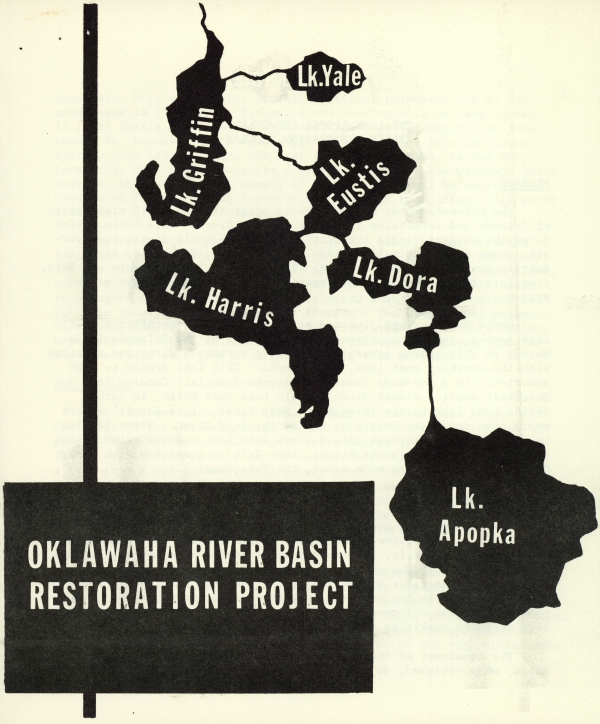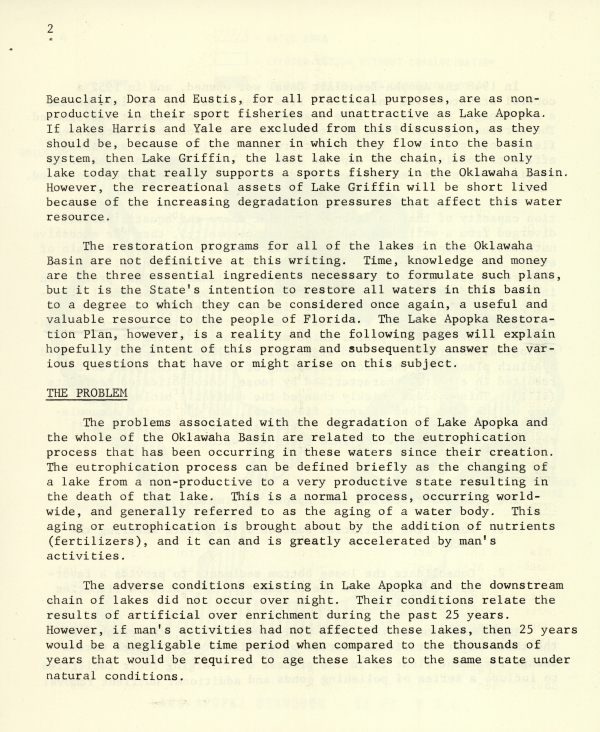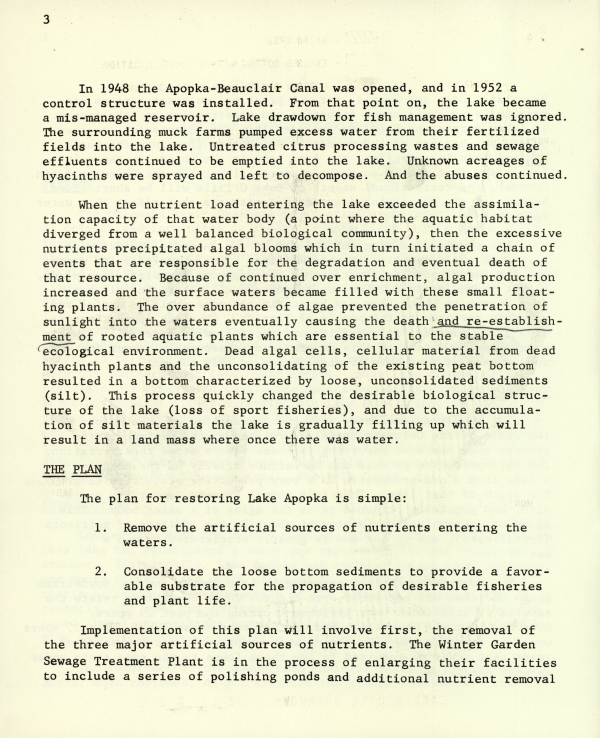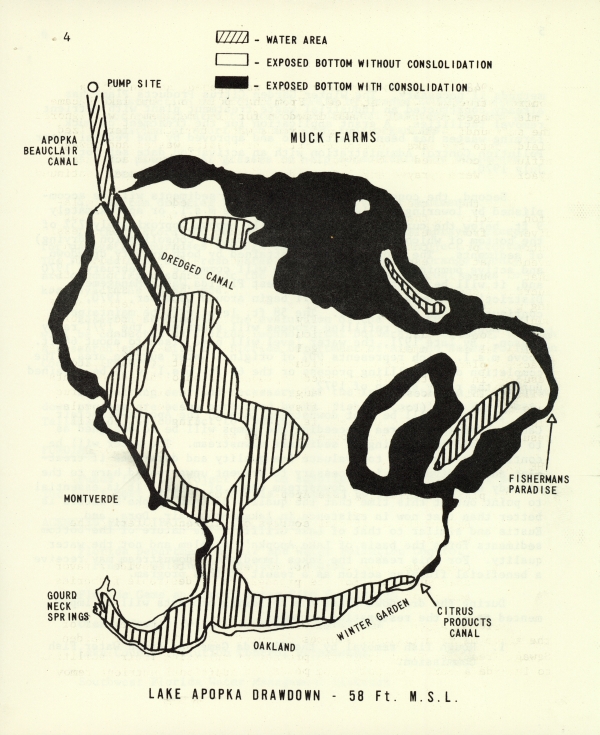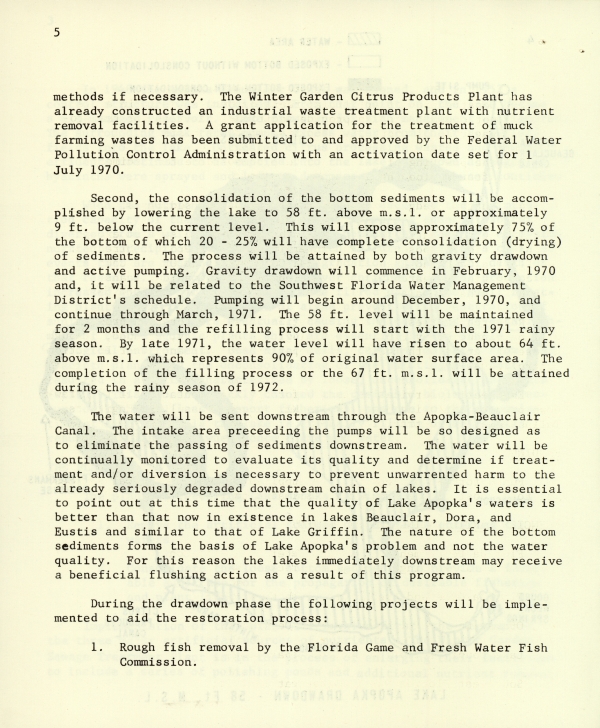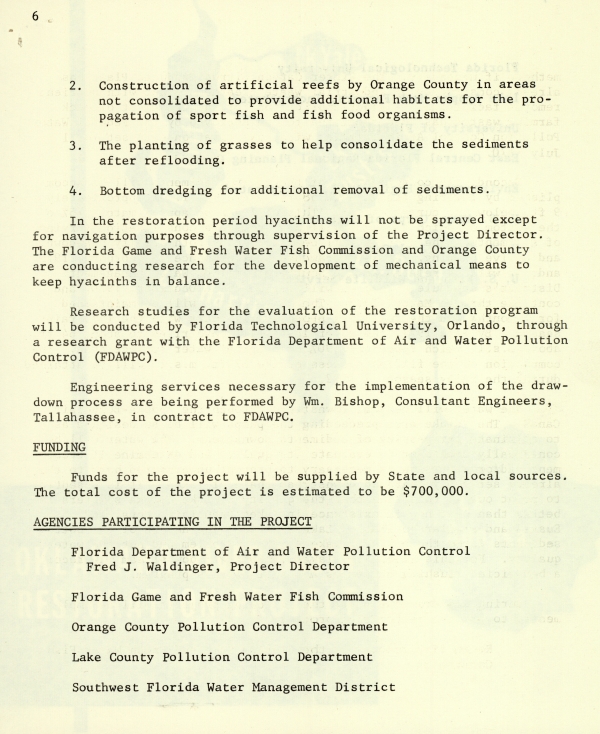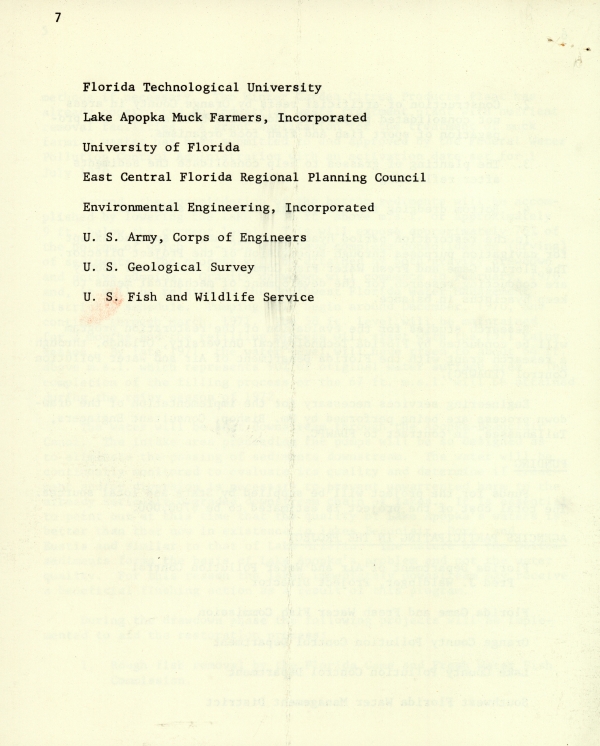Florida Memory is administered by the Florida Department of State, Division of Library and Information Services, Bureau of Archives and Records Management. The digitized records on Florida Memory come from the collections of the State Archives of Florida and the special collections of the State Library of Florida.

State Archives of Florida
- ArchivesFlorida.com
- State Archives Online Catalog
- ArchivesFlorida.com
- ArchivesFlorida.com
State Library of Florida
Related Sites
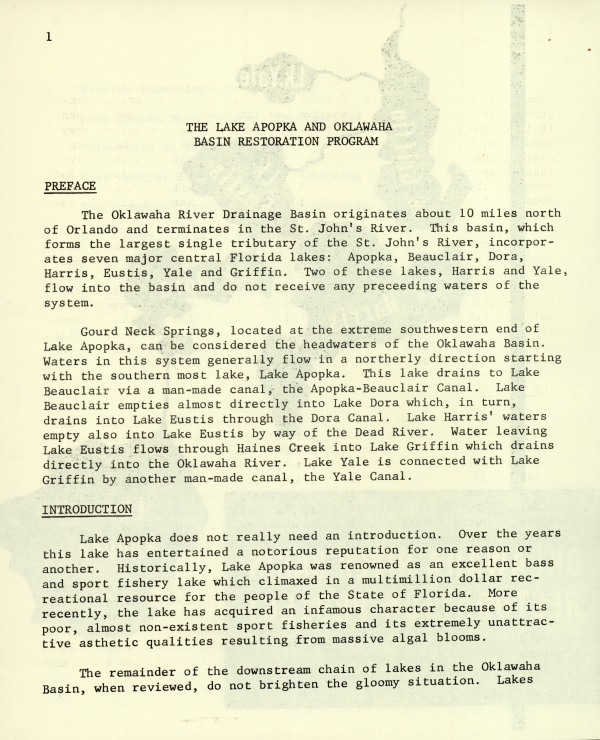
Description of previous item
Description of next item

Source
Description
Date
Contributors
Format
Coverage
Geographic Term
THE LAKE APOPKA AND OKLAWAHA BASIN RESTORATION PROGRAM
PREFACE
The Ocklawaha River Drainage Basin originates about 10 miles north of Orlando and terminates in the St. John's River. This basin, which forms the largest single tributary of the St. John's River, incorporates seven major central Florida lakes: Apopka, Beauclair, Dora, Harris, Eustis, Yale and griffin. Two of these lakes, Harris and Yale, flow into the basin and do not receive any preceeding waters of the system.
Gourd Neck Springs, located at the extreme southwestern end of Lake Apoopka, can be considered the headquarters of the Ockalwaha Basin. Waters in this system generally flow in a northerly direction starting with the southernmost lake, Lake Apopka. This lake drains to Lake Beauclair via a man-made canal, the Apopka-Beauclair Canal. Lake Beauclair empties almost directly into Lake Dora which, in turn, drains into Lake Eustis through the Dora Canal. Lake Harris' waters empty also into Lake Eustis by way of the Dead River. Water leaving Lake Eustis flows through Haines Creek into Lake Griffin which drains directly into the Ocklawaha River. Lake Yale is connected with Lake Griffin by another man-made canal, the Yale Canal.
INTRODUCTION
Lake Apopka does not really need an introduction. Over the eyars this lake has entertained a notorious repuration for one reason or another. Historically, Lake Apopka was renowed as an excellent bass and sport fishery lake whcih climaxed in a multimillion dollar recreation resource for the people of the State of Florida. More recently, the lake has acquired an infamous character because of its poor, almost non-existent sport fisheries and its extremely unattractive asthetic qualities resulting from massive algal blooms.
The remainder of the downstream chain of lakes in the Oklawaha Basin, when reviewed, do not brighten the gloomy situation. Lakes Beauclair, Dora and Eustis, for all practicaly purposes, are as non-productive in their sport fisheres and unattractive as Lake Apopka. If lakes Harris and Yale are excluded from this discussion, as they should be, because of the manner in which they flow into the basin system, then Lake Griffin, the alst lake in the chain, is the only lake today that really supports a sports fishering in the Ocklawaha Basin. However, the recereational assests of Lake Griffin will be short lived because of the increasing degradation pressures that affect this water resource.
The restoration programs for all of the lakes in the Oklawaha Basin are not definitive at this writing. Time, knowledge and money are the three essential ingredients necessary to formulate such plans, but it is the State's intnetion to restore all waters in this basin to a degree to which they can be considered one again, a useful and valuable resource to the people of Florida. The Lake Apopka Restoration Plan, however, is a reality and the following pages will explain hopefully the intent of this prgoram and subsequently answer the various questions that have or might arise on this subject.
THE PROBLEM
The problems associarted with the degratdation of Lake Apopka and the whole of the Oklawaha Basin are related to the eutrophication process that has been occurring in these waters since their creation. The eutrophication process can be defined brielfy as the changing of a lake from a non-productive to a very productive state resulting in the death of that lake. This is a normal process, occurring world wide, and generally referred to as the aging of a water body. This aging or eutrophication is brough about by the addition of nutrients (fertilizers), and it can and is greatly accelerated by man's activities.
The adverse conditons existing in Lake Apopka and the downstream chains of lakes did not occur over night. Their conditions related the results of artificial over enricment during the past 25 years. However, if man's activies had not affected these lakes, then 25 years would be a negligible time period when compared to the thousands of years that would be required to age these lakes to the same state under natural conditions.
Title
Description
Source
Date
Contributor
Format
Language
Type
Identifier
Coverage
Geographic Term
Thumbnail
Display Date
ImageID
topic
Transcript
OKLAWAHA RIVER BASIN RESTORATION PROJECT
Lk. Griffin
Lk. Yale
Lk. Harris
Lk. Dora
Lk. Apopka
THE LAKE APOPKA AND OKLAWAHA BASIN RESTORATION PROGRAM
PREFACE
The Ocklawaha River Drainage Basin originates about 10 miles north of Orlando and terminates in the St. John's River. This basin, which forms the largest single tributary of the St. John's River, incorporates seven major central Florida lakes: Apopka, Beauclair, Dora, Harris, Eustis, Yale and griffin. Two of these lakes, Harris and Yale, flow into the basin and do not receive any preceeding waters of the system.
Gourd Neck Springs, located at the extreme southwestern end of Lake Apoopka, can be considered the headquarters of the Ockalwaha Basin. Waters in this system generally flow in a northerly direction starting with the southernmost lake, Lake Apopka. This lake drains to Lake Beauclair via a man-made canal, the Apopka-Beauclair Canal. Lake Beauclair empties almost directly into Lake Dora which, in turn, drains into Lake Eustis through the Dora Canal. Lake Harris' waters empty also into Lake Eustis by way of the Dead River. Water leaving Lake Eustis flows through Haines Creek into Lake Griffin which drains directly into the Ocklawaha River. Lake Yale is connected with Lake Griffin by another man-made canal, the Yale Canal.
INTRODUCTION
Lake Apopka does not really need an introduction. Over the eyars this lake has entertained a notorious repuration for one reason or another. Historically, Lake Apopka was renowed as an excellent bass and sport fishery lake whcih climaxed in a multimillion dollar recreation resource for the people of the State of Florida. More recently, the lake has acquired an infamous character because of its poor, almost non-existent sport fisheries and its extremely unattractive asthetic qualities resulting from massive algal blooms.
The remainder of the downstream chain of lakes in the Oklawaha Basin, when reviewed, do not brighten the gloomy situation. Lakes Beauclair, Dora and Eustis, for all practicaly purposes, are as non-productive in their sport fisheres and unattractive as Lake Apopka. If lakes Harris and Yale are excluded from this discussion, as they should be, because of the manner in which they flow into the basin system, then Lake Griffin, the alst lake in the chain, is the only lake today that really supports a sports fishering in the Ocklawaha Basin. However, the recereational assests of Lake Griffin will be short lived because of the increasing degradation pressures that affect this water resource.
The restoration programs for all of the lakes in the Oklawaha Basin are not definitive at this writing. Time, knowledge and money are the three essential ingredients necessary to formulate such plans, but it is the State's intnetion to restore all waters in this basin to a degree to which they can be considered one again, a useful and valuable resource to the people of Florida. The Lake Apopka Restoration Plan, however, is a reality and the following pages will explain hopefully the intent of this prgoram and subsequently answer the various questions that have or might arise on this subject.
THE PROBLEM
The problems associarted with the degratdation of Lake Apopka and the whole of the Oklawaha Basin are related to the eutrophication process that has been occurring in these waters since their creation. The eutrophication process can be defined brielfy as the changing of a lake from a non-productive to a very productive state resulting in the death of that lake. This is a normal process, occurring world wide, and generally referred to as the aging of a water body. This aging or eutrophication is brough about by the addition of nutrients (fertilizers), and it can and is greatly accelerated by man's activities.
The adverse conditons existing in Lake Apopka and the downstream chains of lakes did not occur over night. Their conditions related the results of artificial over enricment during the past 25 years. However, if man's activies had not affected these lakes, then 25 years would be a negligible time period when compared to the thousands of years that would be required to age these lakes to the same state under natural conditions.
In 1948 the Apopka-Beauclair Canal was opened, an in 1952 a control structure was installed. From that point on, the lake became a mis-managed reservoir. Lake drawdown for fish management was ignored. The surrounding much farms pumped excess water from their fertilized fields into the lake. Untreated citrus processing wasts and seqage effluents contiued to be emptied into the lake. Unknown acreages of haycinths were sprayed and left to decompose. And the abuses continued.
When the nutrient load entering the lake exceeded the assimilation capacity of that water body (a point where the aquatic habitat divered from a well balanced biological community), then the excessive nutrients precipiated algal blooms which in turn initated a chain of events that are responsible for the degradation and eventual death of that resrouce. Because of this contiunued over enrighment, algal production increase and the surface waters became filled with these small floating plants. The over abundance of algae prevented the penetration of sunlight into the waters eventually causing the death and re-establishment of rooted aquatic plants which are essential to the stable ecological environment. Dead algal cells, cellular material from dead hyacinth plants and the unconsolidating of the existing peat bottom resulted in a bottom characterized by loos, unconsolidated sediments (silt). This process quickly changed the desirable biological structures of the lake (loss of sport fisheries), and due to the accumulation of silt materials the lake is gradually filling up which will result in a land mass where once there was water.
THE PLAN
The plan for restoring Lake Apopka is simple:
1. Remove the artificial sources of nutrients entering the waters.
2. Consolidate the loose bottom sediments to provide a favorable substrate for the propagation of desirable fisheries and plant life.
Implementation of this plan will involve first, the removal of the three major artificial sources of nutrients. The Winter Garden Sewage Treatment Plant is in the process of enlarging their facilties to include a series of polishing ponds and additional nutrient removal
LAKE APOPKA DRAWDOWN - 58 Ft. M.S.L.
[Hatched Square] - WATER AREA
[Empty Square] - EXPOSED BOTTOM WITHOUT CONSOLIDATION
[Black Square] -EXPOSED BOTTOM WITH CONSOLIDATION
PUMP SITE
APOPKA BEAUCLAIR CANAL
MUCK FARMS
DREGGED CANAL
MONTVERDE
FISHERMANS PARADISE
GOURD NECK SPRINGS
OAKLAND
WINTER GARDEN
CITRUS PRODUCTS CANAL
methods if necessary. The Winter Garden Citrus Products Plant has already constructed an industrial waste treatment plant with nutrient removal facilities. A grant application for the treatment of much farming wastes has been submitted to and approved by the Federal Water Pollution Control Administration with an activation date set for 1 July 1970.
Second, the consolidation of the bottom sediments will be accomplished by lowering the lake to 58 ft. above m.s.l. or approximately 9 ft. below the current level. This will expose approximately 75% of the bottom of which 20 - 25% will have complete consolidation (drying) of sediments. The process will be attained by both gravity drawdown and active pumping. Gravity drawdown will commence in February, 1970 and, it will be related to the Southwest Florida Water Management District's schedule. Pumping will begin around December, 1970, and continue through March, 1971. The 58 ft. level will be maintained for 2 months and the refilling process will start with the 1971 rainy season. By late 1971, the water level will have risen to about 64 ft. above m.s.l. which represents 90% of the original water surface area. The completion of the filling process or the 67 ft. m.s.l. will be attained during the rainy season of 1972.
The water will be sent downstream through the Apopka-Beauclair Canal,. The intake area preceeding the pumps will be so designed as to eliminate the passing of sediments downstream. The water will be continually monitored to evaluate its quality and determine if treatment and/or diversion is necessary to preent unwarrented harm to the already seriously degraded downstream chain of lakes. It is essential to point out at this time that the quality of Lake Apopka's water is better that now in existence in lakes Beauclair, Dora, and Esutis and similar to that of Lake Griffin. The nature of the bottom sediments forms the basis of Lake Apopka's problem and not the water quality. For this reason the lakes immediately downstream may received a beneficial flushing action as a result of this program.
During the drawdown phase the following projects will be implemented to aid the restoration process:
1. Rough fish removal by the Florida Game and Fresh Water Fish Commission.
2. Construction of artificial reefs by Orange County in areas not consolidated to provide additional habitats for the propagation of sport fish and fish food organisms.
3. The planting of grasses to help consolidate the sediments after reflooding.
4. Bottom dredging for additional removal of sediments.
In the restoration period hyacinths will not be sprayed except for navigation purposes through supervision of the Project Director. The Florida Game and Fresh Water Fish Commission and Orange County are conducting research for the development of mechanical means to keep hyacinths in balance.
Research studies with the evaluation of the restoration program will be conducted by Florida Technological Univeristy, Orland, through a research grant with the Florida Department of Air and Water Polution Control (FDAWPC).
Engineering services necessary for the implementation of the drawdown process ar ebeing performed by Wm. Bishop, Consultant Engineers, Tallahassee, in contract to FDAWPC.
FUNDING
Funds for the project will be supplied by state and local sources. The total cost of the project is estimated to be $700,000.
AGENCIES PARTICIPATING IN THE PROJECT
Florida Department of Air and Water Pollution Control
Fred J. Waldinger, Project Director
Florida Game and Fresh Water Fish Commission
Orange County Pollution Control Department
Lake County Pollution Control Department
Southwest Florida Water Management District
Florida Technological University
Lake Apopka Much Farmers, Incorporated
University of Florida
East Central Florid Regional Planning Council
Environmental Engineering, Incorporated
U.S. Army, Corps of Enginers
U.S. Geological Survey
U.S. Fish and Wildlife Service
Chicago Manual of Style
Ocklawaha River Basin Restoration Project - booklet. 1969 (circa). State Archives of Florida, Florida Memory. <https://www.floridamemory.com/items/show/297486>, accessed 6 December 2025.
MLA
Ocklawaha River Basin Restoration Project - booklet. 1969 (circa). State Archives of Florida, Florida Memory. Accessed 6 Dec. 2025.<https://www.floridamemory.com/items/show/297486>
AP Style Photo Citation

 Listen: The Assorted Selections Program
Listen: The Assorted Selections Program